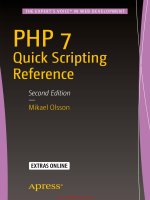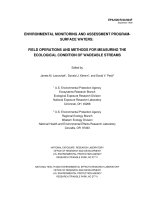Sanet cd excel for analysts lookup reference functions tủ tài liệu training
Bạn đang xem bản rút gọn của tài liệu. Xem và tải ngay bản đầy đủ của tài liệu tại đây (480.04 KB, 10 trang )
Named
Ranges
Using Named Arrays can simplify a lookup function if you use the same
data array in multiple formulas
For example, if you name the array from A1:D6 “Apparel”…
…you can write your vlookup formula in either of
the following ways:
=VLOOKUP(A1,$A$1:$D$6,2)
=VLOOKUP(A1,Apparel,2)
30
VLOOKUP
Let’s take a look at one of Excel’s most common reference functions – VLOOKUP:
=VLOOKUP(lookup_value, table_array, col_index_num, [range_lookup])
This is the value that
you are trying to match
in the table array
This is where you
are looking for the
lookup value
Which column
contains the data
you’re looking for?
Are you trying to match the
exact lookup value (0), or
something similar (1)?
D2=VLOOKUP(A2, $G$1:$H$5, 2, 0)
To populate the Price in
column D, we look up the name
of the product in the data array
from G1:H5 and return the
value from the 2nd column over
31
HLOOKUP
Use HLOOKUP if your table array is transposed (variables headers listed in rows)
=HLOOKUP(lookup_value, table_array, row_index_num, [range_lookup])
This is the value that
you are trying to match
in the table array
This is where you
are looking for the
lookup value
Which column
contains the data
you’re looking for?
Are you trying to match the
exact lookup value (0), or
something similar (1)?
D2=HLOOKUP(A2, $H$1:$L$2, 2, 0)
With an HLOOKUP, we search for the product name
in F1:J2 and return the value from the 2nd row down
32
Laws
of
Lookups
There are two key rules that constrain VLOOKUP and HLOOKUP formulas:
1. The lookup value must be in the first column of a
VLOOKUP table array or the first row of a HLOOKUP
table array
2. Excel will always return the value from the top most
row or left most column of a table array when
multiple instances of the lookup value are present
PRO TIP:
Avoid breaking Law #2 by identifying a “Key”
that is common to both datasets and is unique
for every row (NOTE: Keys often take the form
of a concatenation of multiple fields)
33
ROW/ROWS
The ROW function returns the row number of a given reference, while the ROWS
function returns the number of rows in a given array or array formula
=ROW([reference])
=ROWS(array)
ROW(C10) = 10
This example uses an array, which is why
it includes the fancy { } signs – more on
that in the ARRAY functions section
ROWS(A10:D15) = 6
ROWS({1,2,3;4,5,6}) = 2
34
COLUMN/COLUMNS
The COLUMN function returns the column number of a given reference, while the
COLUMNS function returns the number of columns in a given array or array formula
=COLUMN([reference])
=COLUMNS(array)
PRO TIP:
COLUMN(C10) = 3
Leave the cell reference out and just
write ROW() or COLUMN() to return the
row or column number of the cell in
which the formula is written
COLUMNS(A10:D15) = 4
COLUMNS({1,2,3;4,5,6}) = 3
35
INDEX
The INDEX function returns the value of a specific cell within an array
=INDEX(array, row_num, column_num)
What range of cells
are you looking at?
How many rows down
is the value you want?
How many columns over
is the value you want?
INDEX($A$1:$C$5, 5, 3) = 234
In this case we’re telling Excel to find the value of a cell
somewhere within the array of A1:C5. Starting from the
upper left, we move down to the 5th row and right to the
3rd column, to return the value of 234
36
MATCH
The MATCH function returns the position of a specific value within a column or row
=MATCH(lookup_value, lookup_array, [match_type])
What value are you trying
to find the position of?
In which row or column are
you looking? (must be a 1dimensional array)
Are you looking for the exact value
(0), or anything close?
1: Find largest value < or = lookup_value
0: Find exact lookup_value
-1: Find smallest value > or = lookup_value
MATCH(“Pliers”,$A$1:$A$5, 0) = 4
MATCH(66,$A$3:$C$3, 0) = 3
Matching the word “Pliers” in column A, we
find it in the 4th row. Matching the number 66
in row 3, we find it in the 3rd column
37
INDEX/MATCH
INDEX and MATCH are commonly used in tandem to act like a LOOKUP function; the
only difference is that INDEX/MATCH can find values in any column or row in an array
Example: Price Checker
In this example, we want to populate the price of a given product and
size in cell B10 by returning a particular value within the array B2:D4
B10=INDEX(B2:D4, MATCH(B6,A2:A4,0), MATCH(B8,B1:D1,0))
The number of rows down to index
depends on what product I’m
looking for, so we use a MATCH
function and search for the value
in cell B6 (in this case “Pants”)
The number of columns over to
index depends on what size I’m
looking for, so we use a MATCH
function and search for the value
in cell B8 (in this case, “Medium”)
Considering the output of each MATCH function, the formula is just a simple INDEX:
B10 = INDEX(B2:D4, 3, 2) = $30
38
OFFSET
The OFFSET function is similar to INDEX, but can return either the value of a cell
within an array (like INDEX) or a specific range of cells
=OFFSET(reference, rows, columns, [height], [width])
What’s your
starting point?
How many rows
down should you
move?
How many
columns over
should you move?
An OFFSET formula where [height]=1
and [width]=1 will operate exactly like an
INDEX. A more common use of OFFSET
is to create dynamic arrays (like the
Scroll Chart example in the appendix)
If you want to return a
multidimensional array, how
tall and wide should it be?
PRO TIP:
Don’t use OFFSET or INDEX/MATCH
when a simple VLOOKUP will do the trick
39









